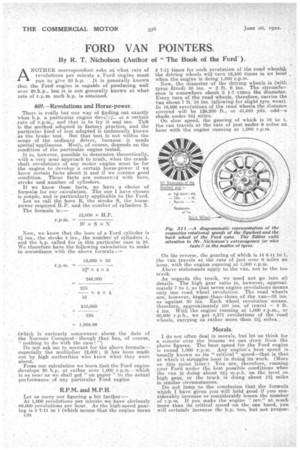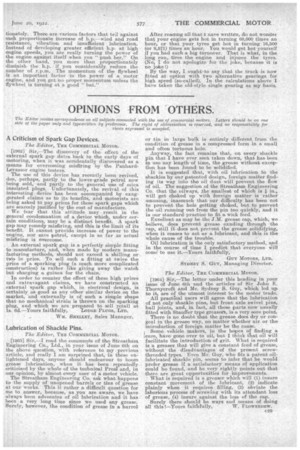FORD VAN POINTERS.
Page 28

Page 29

If you've noticed an error in this article please click here to report it so we can fix it.
By R. T. Nicholson (Author of "The Book of the Ford' ).
AN OTHER correspondent asks at what rate of revolutions per minute a. Ford engine must run to give 20 h.p. It is generally known that the Ford engine is capable of producing well over 20,h.p., but, it is not' generally known at what rate of r.p.m. such h.p. is attained.
469.—Revolutions and Horse-power.
There is really but one way of ncling nut exactly what h.p. a particular engine deve-....4.,„ at a certain rate erf r.p.m., and that is to try it and see. Thit is the method adopted in factory practice, and the particular kind of test adopted is technically known as the brake test. But that test is not within the scope of the ordinary driver, because it needs spedial appliances. Much, of course, depends on the condition of the particular engine tested.
It is, hoWeve.r, possible to determine theoretically, with a very near approach to truth, what the crankshaft revolutions of any motor engine must be for the engine to develop a certain horse-power if we know certain facts about it and if we assume good condition. Those facts are concerned with bore, stroke and number of cylinders.
If we know those facts, we have a choice -of formulte for our calculation. The one I have chosen is simple, and is particularly applicable to the Ford.
Let us call the bore B, the stroke S, the horsepower required H.P. and the number of cylinders N.
The formula is
Now, we know that the bore of a Ford cylinder is 31 ins., the stroke 4 ins., the number of cylinders 4, and the h.p. called for in this particular case is 20. We therefore have the following calculation to make in accordance with the above formula :—
(which is curiously somewhere about the date of the Norman Conquest—though that has, of course, " nothing to do with the case! ") Do not ask me to account for the above formula— especially the multiplier 12,000; it 'has been made out by high authorities who knew what they were about.
From our caIculatibn we learn that the Ford engine develops 20 h.p. at rather over 1,000 r.p.m.—whieh is as near as we shall get "on paper" to the actual performance of any particular Ford engine
R.P.M. and M.P.H.
Let us carry our figuring a bit farther:—
At 1,000 revolutions per minute we have obviously 60,000 revolutions Per hour. As the high-speed gearing is 3 7-1/ to 1 (Which means that the engine turns c28
3 7-11 times for each revolution of the road wheels), the driving wheels will turn. 16,500 times in an hour when the engine is doing 1,000 r.p.m. Now, the diameter of the driving wheels is (with tyres fitted) 30 ins. = 2 ft. 6 ins. The circumference is somewhere about 3 1-7 -times the diameter. Every turn of the road wheels, therefore' carries the van about 7 ft.' 10 ins. (allowing for slight tyre wear). In 16,500 revolutions of the road wheels the distance covered will be 129,250 ft., or 43,083 yds. odd—a shade under 24?-f
On slow speed, the gearing of which is 10 to 1, the van travels at the rate of just under 9 miles an hour with the engine running at 1,000 r.p.m.
On the reverse, the gearing of which is 14 6-11 to 1, the van travels at the 'rate of just over'6 miles an . hours with the engine running at 1,000 r.p.m.
Above statements apply to the van, not to the ton truck.
As regards the truck, we need not •go into all details. The high gear ratio is, however, approximately 7 to 1, so that seven engine revolutions means only one road wheel revolution. The road wheels :are, however, bigger .than,those. of the van-732 ins. as against 30 ins. Each wheel revolution means, therefore, approximately 100 ins, of travel = 8 ft. 4 ins.. With the engine running at 1,000 r.p.m., or 60,000 r.p.h., we get 8,571 revolutions of the road wheels, carrying us rather more than 131 miles.,
Morals.
I do not often deal in morals, but let us think for a minute over the lessons we can draw from the above figures. The best speed for the Ford engine is round 1,000 r.p.m. Any 'engine's best speed is usually known as its " critical' .-speed—that is that at which it struggles least in doing its work. (More on this point later.) You are, therefore, running your Ford under the best possible conditions when the van is doing about 24,, m.p.h. on the level on high gear, or the truck, is doing about 131 miles in similar circumstances.
Do not jump to the conclusion that the formula which I have given you will hold good if you considerably increase or considerably lessen the number of r.p.m. If you make the engine " rev." at much more than its critical speed on the one hand, you will certainly increase the h.p. too, but.not propor tionateIy. There are various factors that tell against such proportionate increase of h.p.—wind and road resistance, vibration and insufficient lubrication. Instead of developing greater efficient h.p. at high engine speeds, you are really turning the power of the engine against itself when you "push her." On the other hand, you more than proportionately diminish the h.p. if you considerably reduce the number of r.p.m. The momentum a the flywheel is an important factor in the power of a motor engine, and you get no proper momentum unless the flywheel is turning at a good " bat."
After reading all that I nave written, do not wonder that your engine gets hot in turning 60,000 times an hour, or that your tyres get hot in turning 16,500 (or 8,571) times an hour. You would get hot yourself if you had such a big turno_ver. That is what, in the long run, tires the engine and injures the tyres. (No, I do not apologize for the joke, because it is no joke I) By the way, I ought' to say that the truck is now fitted at option with two alternative gearings for high speed (so-called). In the calculations above I have taken the old-style single gearing as my basis.
































